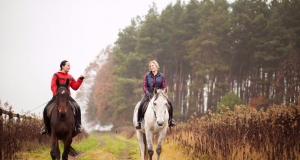Natural horse hoof care involves more than just taking off the horse shoes. Natural hoof care is part of a balanced diet and exercise routine, and is influenced heavily by the natural terrain in which a horse lives. Natural hoof care integrates attributes of hoof shape and development of wild, or un-domestic horses into practices that help domestic horses.
Wild Horses
Wild horses live for decades without shoes, and are perfectly “sound” or capable of traveling long distances. Horse hoofs are composed of many different types of tissue, all working in tandem to support the horse. Hooves are combinations of bone, fleshy tissue and “fingernail-like” substances. The correct position and ratios of each type of tissue depends on the horse’s natural environment.
In the wild, horse hooves shape themselves based on the terrain. Horses living in rocky, abrasive and hilly terrain have much differently shaped hooves than horses living on sandy, flat and marshy areas. Each portion of the hoof performs specific duties, and the terrain influences the growth and shape of individual parts to work together as a whole, in a manner best suited for the environment.
Modern Hoof Care
Traditional, modern hoof care calls for routine trimming and shoeing of domestic horses in order to keep them sound and moving well. Too often, shoes are seen as the “cure all” for any lameness, or difficulty with mobility, when in actuality, many factors contribute to foot health. A horse’s diet strongly influences its circulation, and thus the health of its extremities. As the hoof is composed of living tissue, any problems with circulation will eventually affect overall health of the hoof. If a horse has hoof problems, it is important to look at its overall routine.
Natural Trimming
An integral part of natural hoof care is trimming. In the wild, horse hooves are naturally filed and trimmed by the terrain over which they roam—some as much as 20 or 30 miles a day. Domestic horses often do not have the luxury of unlimited travel over varied terrain. Trimming the hooves in a specific way mimics the way hooves naturally wear in the wild. As previously stated, the terrain makes a big difference in development of hooves. When artificially simulating this natural wear and tear, the person trimming the hoof must develop a plan to trim the hoof in a manner that will benefit the horse in its current environment.
A naturally trimmed, “barefoot” horse will develop hard, callused feet that can stand up to wear and tear, and protect themselves against bacteria, fungus and infections. The naturally trimmed hoof, when maintained correctly, and in balance with the rest of horse care, provides a more authentic stance for the horse, thus reducing its risk of debilitating lameness due uncomfortable conditions and compensation.
Benefits of Natural Hoof Care
Natural hoof care is beneficial to horse and owner. When properly practiced, natural hoof care makes the horse more “sound” and better in the ring, at pasture, and on the trail. Natural hoof care reduces fees for shoeing horses, and for vet bills to treat lame horses. It can extend the working life of a domestic horse, and will increase comfort of the horse.
Article source: Expert Articles
















